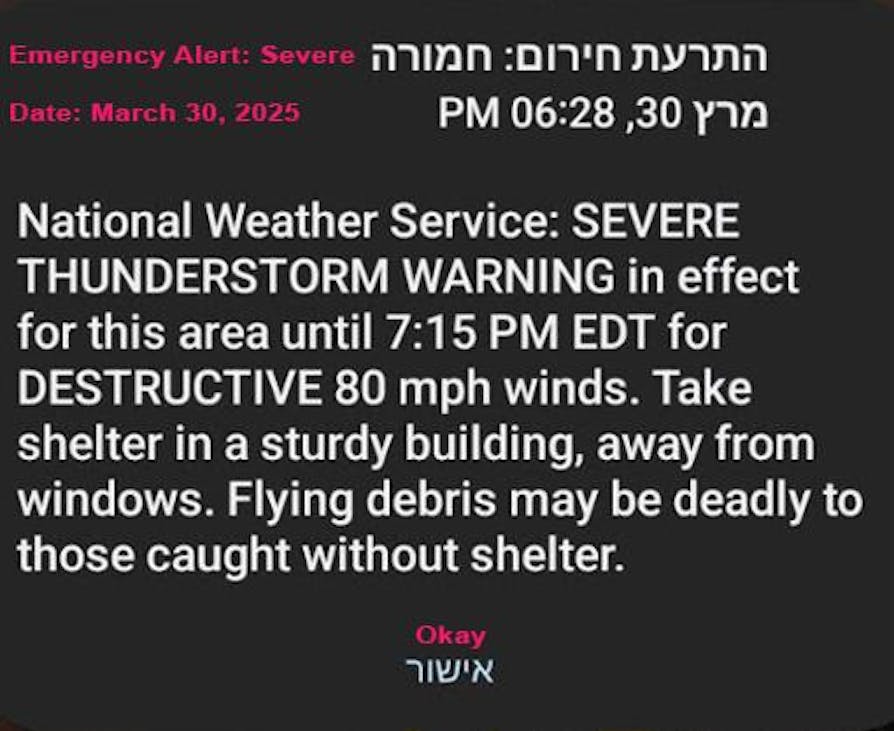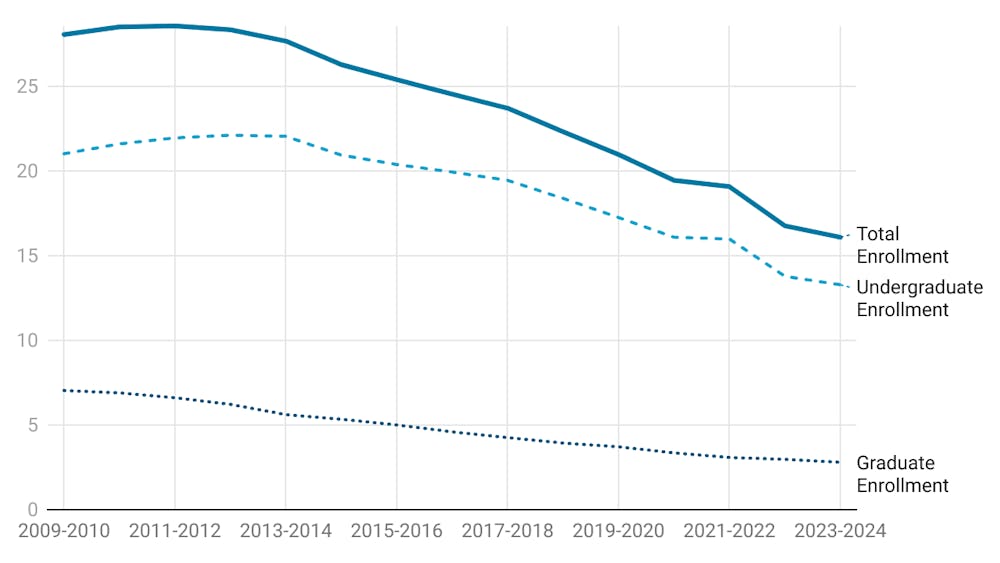The National Weather Service predicts warmer than average temperatures for June in Michigan.
That warmer air also increases the possibility of additional storms, but forecasters warn that late spring weather is often hard to predict. Forecasters said that the transition from spring to summer creates more unpredictable weather patterns. Meteorologists call this the spring predictability barrier.
Whatever the forecast, emergency teams stand ready for potential severe weather.
Eastern Michigan University Police Chief Matthew Lige said his department recognizes and plans for that unpredictability. He and the university's Department of Public Safety encourage all staff and students to be aware of potentially serious situations and stay informed through systems such as National Weather Service alerts and the university's own alert system.
“The first thing that comes to mind is tornado season," Lige said.
The spring to summer weather transition, particularly when cold and warm air masses collide, can cause storms and tornadoes.
Lige said that during his three years as Eastern's police chief, he has seen increasingly frequent anomalous weather patterns in Michigan.
How tornadoes form
The National Weather Service defines tornadoes as narrow, violently rotating columns of air that extend from a thunderstorm to the ground.
Tornado formation can be explained in three steps, as reported by meteorologists at the Department of Meteorology & Atmospheric Science at Penn State University.
The first step occurs when wind shear, which is a difference of wind speed and direction over a short distance, initiates the development of a spinning action known as warm updrafts. The second is when a wall of rain and hail initiates a lower, horizontal-spinning wind called a cold downdraft. The third step is the interaction between the two winds, which creates an intense cyclonic action close to the ground.
Warning systems
Lige said his department works on several levels to be prepared for unpredictable weather. The department tests the notification systems every month. On the first Friday afternoon of each month, the department tests the outdoor siren system and outdoor public address system.
The next test is scheduled for Friday, June 6, at noon.
The test will include seven outdoor speakers and all of the buildings with indoor systems. According to a campus-wide email from public safety officials, the activation of text messages, email, Facebook, Twitter, desktop alerting, and Voice over Internet Protocol phones will be excluded.
“Emergency notification systems matter. And they matter when you need them the most,” Lige said. “My worry, and not really a worry, but something I'm cognizant of, is as annoying as testing of those systems can be, I have an obligation to make sure we test those systems because there's that moment in time we need them."
Warnings were issued March 30, 2025, when the National Weather Service reported several lines of storms forming in lower Michigan. Strong winds tore down trees, and at least 35,000 households lost power for hours. Weather service meteorologists reported wind gusts of up to 96 mph at the Jackson County Airport.
Moreover, the National Weather Service spotted two brief tornadoes in Michigan, one in New Haven Township and the second in south Milan.
Some hours before storms rolled across the state that day, the national emergency services sent text notifications to Michigan residents, warning people about the expected storms. Among the messages was the one below, which warns of destructive winds that could send unsecured debris flying through the air.

The National Weather Service sent this emergency alert March 30, 2025, as storms with severe winds moved across lower Michigan.
On campus, students might be alerted through loudspeaker announcements. The university operates an outdoor public address system with seven zones around campus that can be used in case of emergencies, including severe weather. The speakers are located at Phelps Hall, King Hall, Goddard Hall, the Halle Library, the Student Center, the convocation center and near the sculpture studio.
Additional outdoor warning sirens are operated by Washtenaw County Emergency Management. These sirens are used to alert people across the county about severe weather. EMU reported that two of Washtenaw County's 39 speakers are located on the university's campus.
Lige said his safety department sends alert messages to students with specific directions.
On Sunday, March 30, at 6:33 p.m., EMU emailed students the following message: “EMU CRITICAL: Severe Weather Warning issued for Washtenaw County until 7:15 p.m. Very high winds expected. Seek shelter immediately. Stay away from glass.”
The storm ended with no reported damage on EMU's campus.
Understanding the warnings
Lige said the safety department system relies heavily on the National Weather Service meteorologists, the National Oceanic and Atmospheric Administration Storm Prediction Center, and the science behind predicting weather. When the safety department receives a notification of severe weather on its way, alerts are sent to students according to the warnings.
The center, operated by NOAA, monitors the weather 24/7 across the entire U.S. for conditions that are favorable for tornadoes and severe weather. The agency regularly provides six-hour forecasts.
So, Lige said, the university usually knows six hours ahead of time if a storm is expected in the area. That's when the department emergency teams decide whether to send notices on the university system and whether classes should be cancelled or the campus closed.
When it comes to tornadoes, the center issues two types of notices: watches and warnings.
A tornado watch means that weather conditions exist that allow for the formation of a tornado. Such watches are issues for regions, states and sometimes several states at a time. In those watch notices, residents are encouraged to watch and prepare for severe weather and stay tuned for additional information.
Tornado warnings are issued by local weather service meteorologists when someone has spotted a tornado or when one has been indicated by radar. Tornado warnings indicate there is a serious threat to life and property and are issued for those in the expected path of the storm system. In those notices, residents are told to find safe shelter immediately. Tornado warnings can cover parts of counties or several counties in the path of danger.
Emergency response
Other weather hazards include heavy rain with flooding, heavy snow with limited visibility and slippery conditions, and even extreme wind gusts.
“We are going to do everything we can to make sure students are safe and can make informed decisions," Lige said.
Lige said students should pay attention to emergency alerts and follow the directions they give. He also recommended that students and their parents sign up for Eagle Alerts, the campus emergency network. Those who opt in to the network are notified via text alerts about all campus and community emergencies, including severe weather warnings.
The university automatically enrolls all current students, faculty, and staff email notifications. However, students must sign up to receive text alerts on their mobile devices. The mobile notification service is provided through Rave Mobile Safety.
There are several types of notifications students might receive. For example, if wind gusts are greater than 70 mph, the safety department will notify those on campus to stay away from glass or windows because the wind speed could shatter a window. If students are around the Student Center, with its several-story-high wall of glass, they should immediately find an area with more shelter.
All buildings on campus have posted emergency response signs, offering instruction on what to do and where to find shelter when the weather turns bad.
Students who want to learn more can contact the Department of Public Safety and Police at any time. The doors are open, Lige said. The building is at EMU at 1200 Oakwood St. in Ypsilanti.

Matthew "Matt" Lige, the police chief with Eastern Michigan University’s Department of Public Safety, opens the webpage for the Eagle Alert system on campus, demonstrating how students can sign up to get emergency notifications on their mobile devices.










